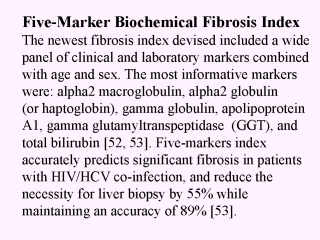 |
On a scale from zero to
1.00, the five-marker index had a positive predictive value of 86% for scores greater than
0.60, and a negative predictive value of 93% for scores of 0.20 or less. These thresholds
could reduce the necessity for liver biopsy by 55% while maintaining an accuracy of 89%
[53]. The diagnostic value of five-markers index was assessed in patients included in a
randomized trial of interferon (IFN) using repeated measurements and two biopsies (78
patients) [54]. A fibrosis index combining five biochemical markers as well as hyaluronic
acid was assessed at the baseline, at the end of treatment and at the end of 72 week
follow-up. There was a significant decrease of the fibrosis index score among the
sustained virologic responders (17 pts; from 0.33 +/- 0.06 (mean +/- SE) at baseline to
0.18 +/- 0.06 at 72 weeks) in comparison with non-responders (92 pts; from 0.41 +/- 0.03
at baseline to 0.44 +/- 0.03 at 72 weeks; P < 0.001) or relapsers (56 pts; from 0.36
+/- 0.03 at baseline to 0.32 +/- 0.03 at 72 weeks; P=0.05) [54]. The discriminative value
of the biochemical index combined with the levels of hyaluronic acid was not statistically
significantly different from that of the five-marker index alone [54]. Myers et al. assessed the discriminative value of
the combination of five biochemical markers and historical index (211 CHC patients) [55].
By multivariate logistic regression analysis, sex (p = 0.003), age at biopsy (p = 0.004),
and alcohol consumption (p = 0.042) were independently predictive of F2-F4 fibrosis. A
simple index including age, sex, and five biochemical markers accurately predicts
significant hepatitis C-related fibrosis. The discriminative value of the combined
biochemical and historical index was not statistically significantly different from that
of the fivemarker index alone [55]. |
